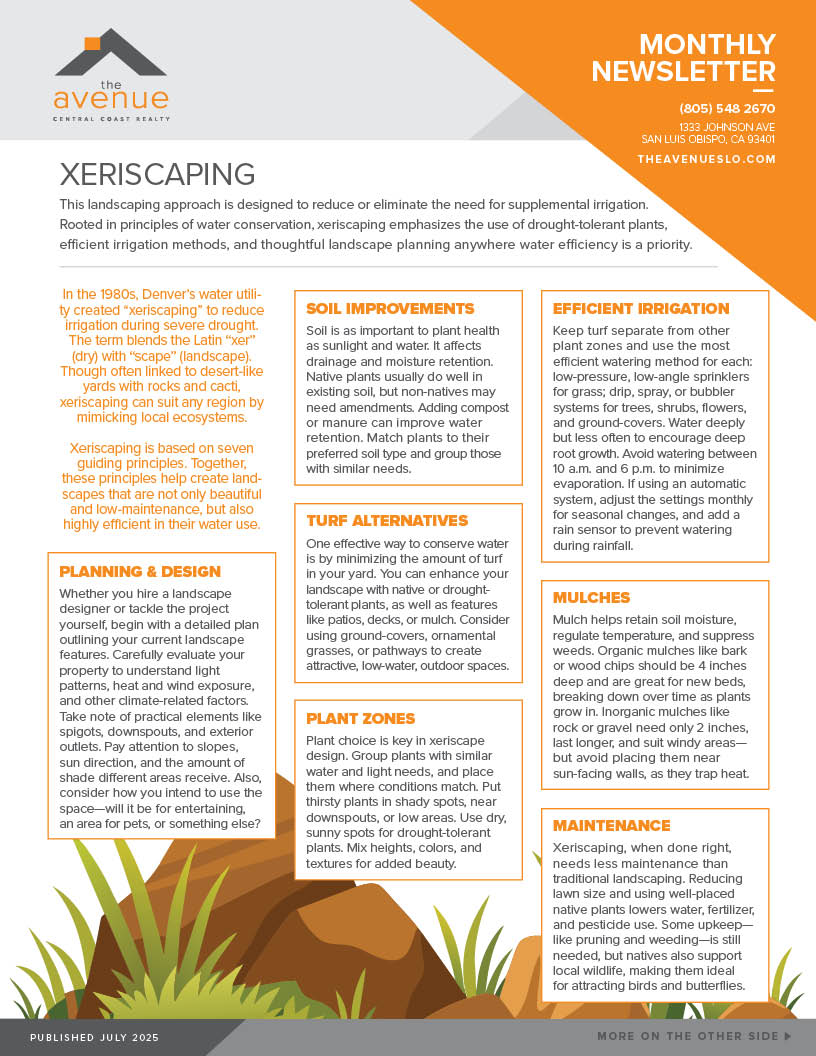SLO County Market Update & Article on Xeriscaping
*INTERESTING FACT –
July is Paso Robles’ busiest month for tourism. This year, the Mid State Fair expects 400,000 visitors will attend the 12-day event.
Xeriscaping
This landscaping approach is designed to reduce or eliminate the need for supplemental irrigation. Rooted in principles of water conservation, xeriscaping emphasizes the use of drought-tolerant plants, efficient irrigation methods, and thoughtful landscape planning anywhere water efficiency is a priority.
In the 1980s, Denver’s water utility created “xeriscaping” to reduce irrigation during severe drought. The term blends the Latin “xer” (dry) with “scape” (landscape). Though often linked to desert-like yards with rocks and cacti, xeriscaping can suit any region by mimicking local ecosystems.
Xeriscaping is based on seven guiding principles. Together, these principles help create landscapes that are not only beautiful and low-maintenance, but also highly efficient in their water use.
Planning & Design
Whether you hire a landscape designer or tackle the project yourself, begin with a detailed plan outlining your current landscape features. Carefully evaluate your property to understand light patterns, heat and wind exposure, and other climate-related factors. Take note of practical elements like spigots, downspouts, and exterior outlets. Pay attention to slopes, sun direction, and the amount of shade different areas receive. Also, consider how you intend to use the space—will it be for entertaining, an area for pets, or something else?
Soil Improvements
Soil is as important to plant health as sunlight and water. It affects drainage and moisture retention. Native plants usually do well in existing soil, but non-natives may need amendments. Adding compost or manure can improve water retention. Match plants to their preferred soil type and group those with similar needs.
Turf Alternatives
One effective way to conserve water is by minimizing the amount of turf in your yard. You can enhance your landscape with native or drought-tolerant plants, as well as features like patios, decks, or mulch. Consider using ground-covers, ornamental grasses, or pathways to create attractive, low-water, outdoor spaces.
Plant Zones
Plant choice is key in xeriscape design. Group plants with similar water and light needs, and place them where conditions match. Put thirsty plants in shady spots, near downspouts, or low areas. Use dry, sunny spots for drought-tolerant plants. Mix heights, colors, and textures for added beauty.
Efficient Irrigation
Keep turf separate from other plant zones and use the most efficient watering method for each: low-pressure, low-angle sprinklers for grass; drip, spray, or bubbler systems for trees, shrubs, flowers, and ground-covers. Water deeply but less often to encourage deep root growth. Avoid watering between 10 a.m. and 6 p.m. to minimize evaporation. If using an automatic system, adjust the settings monthly for seasonal changes, and add a rain sensor to prevent watering during rainfall.
Mulches
Mulch helps retain soil moisture, regulate temperature, and suppress weeds. Organic mulches like bark or wood chips should be 4 inches deep and are great for new beds, breaking down over time as plants grow in. Inorganic mulches like rock or gravel need only 2 inches, last longer, and suit windy areas—but avoid placing them near sun-facing walls, as they trap heat.
Maintenance
Xeriscaping, when done right, needs less maintenance than traditional landscaping. Reducing lawn size and using well-placed native plants lowers water, fertilizer, and pesticide use. Some upkeep—like pruning and weeding—is still needed, but natives also support local wildlife, making them ideal for attracting birds and butterflies.





